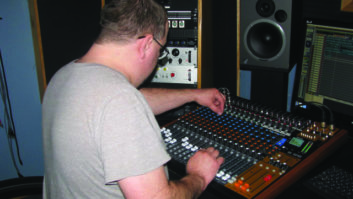(click thumbnail)The TASCAM US-122 USB Audio/MIDI Interface is an easy way to add a quality two-channel audio I/O to most USB-equipped computers, either PC or Mac. While designed with pro audio applications in mind, this is a simple, portable, cost-effective package that does the trick for radio producers.
The book-sized US-122 (5.9 inches by 2.4 inches by 7.7 inches) has enough real estate so that TASCAM’s sensible design gives easy-access to I/O and controls.
On the bottom, two phantom-powered Neutrik XLR mic inputs are placed alongside two line-level 1/4-inch TRS jacks. A pair of channel inserts allow for compressors and other hardware devices to be inserted into the audio chain. On the opposite end, RCA line-outs are next to a 1/4-inch headphone jack, the MIDI I/Os and the USB connector.
Knobs and switches
The top control panel has five knobs and five switches. The bottom row sets the levels on the XLRs and TRS inputs. One switch is the on/off for phantom power. Two others are for musicians to switch the mic/line levels on the inputs to guitar level for direct instrument recording.
Product CapsuleThumbs Up
Solid construction
Easy to install/understand
Excellent value
Thumbs Down:
Low volume for headphone monitoring
No metering to set input levels
Price: $269
Contact: TASCAM in California at (323) 726-0303 or visit www.tascam.com
The two channels operate independently so that a line source can be recorded simultaneously on channel 1 next to a mic input voiceover on channel 2 – or a guitar solo, if you are so inclined.
The top row has a pair of knobs that set levels for the Headphones and Line Out. A switch puts the two channels into mono mode, helpful for voiceover-only work.
The last knob/switch is for direct monitoring. The ability to add compressors and the like through the channel inserts creates latency. Direct monitor mode cuts out these add-ons from monitoring but leaves them in the audio chain for recording.
Road ready
The metal case of US-122 has a nice, rugged feel and heft, weighing in at 2 pounds.
I was anxious at first about a bit of play and jiggle in the knobs and switches. The knobs don’t rattle around changing settings, but the individual assemblies shift.
After several months of bouncing the unit in and around in real-world use without any problems, it seems that this issue is, in fact, a feature. The added “give” lets the unit soak up some of the rough-and-tumble. This is ready for the road.
To hook up the US-122, install the drivers and plug the unit in with a standard USB 1 cable. The included drivers cover the whole PC/Mac universe with support for ASIO, WDM, GSIF, Sound Manager and Apple Core Audio (OSX) standards.
The US-122 is a USB 1.1 device, which begs the question: Is it compatible with the latest high-speed USB 2.0? Yes – USB 2.0 is backward compatible. So why didn’t TASCAM opt for the latest? Given the bandwidth needs for two-channel recording, the older standard is quite sufficient.
A nice feature is how the unit is powered by the USB port. There is no need for batteries or an external power supply. An LED lights up to show that connection is established. Other LEDs glow to show that there is an audio signal and can warn if the levels are too high. Metering is done through software only.
Software included
The US-122 comes with a bundle of software including a “lite” PC and Mac OS 9 versions of Steinberg’s Cubasis MIDI and audio sequencer. But the unit will work with most any other package. Bench tests on an IBM X20 laptop with Adobe Audition (formerly Cool Edit Pro) showed this to be a quiet interface with 91dB S/N ratio. That may not match 100+ dB studio units designed for ultra high-resolution recording, but it is more than sufficient for radio work.
Although this can work well in the studio, this is really at home on the road. Field use with Sound Forge 6 in a variety of settings showed no significant noise. Basically, the unit does the job of bringing audio into the computer admirably. It is easy to install, operate and understand. For those familiar with their desktop DAW software, there’s really nothing new to learn.
My issues with the US-122 were few. At times, I had to crank it up the headphone gain all the way to get enough volume on my Sennheiser HD25s. Also, matching levels L/R for a stereo recording required eyeballing the marks by the knobs. In a low light situation, that can be problematic. Better to add a few LEDs to make this more of a mini-mixer to get an actual level. Of course, this can be done with the unit as it is through the software.
With a list price of $269, the TASCAM US-122 is a remarkable value for those wanting to turn a laptop into a full-fledged DAW.







